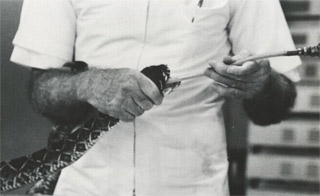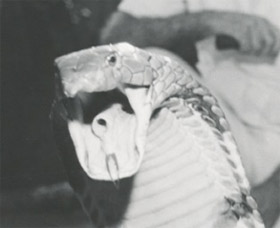
Force-feeding an eastern diamondback rattlesnake.
The cornerstone of Bill's success of being able to maintain venomous snakes alive for a much longer period of time, sometimes for years, was the concept and perfection of a special way of providing food to the reluctant reptiles, a system he called force-feeding. For the most part venomous snakes are very high strung, easily put on the defensive, designed to be hidden, and often refuse to eat in captivity, especially when handled for venom collection. In addition, the diet of each species is quite varied; while the most common fare are rats and mice, the tree snakes hunt birds, snakes found in and around the water eat frogs and fish, some eat lizards, and some snakes eat nothing but other snakes.
So, in Bill's very organized and practical mind, in an attempt to overcome the fact that most of the snakes handled were not going to eat, even if they would that would necessitate having to keep on hand enormous numbers of rodents, fish and frogs, birds and snakes; open each cage, put the food in, go back later to see who ate and who did not, and the dilemma of what to do with those (the majority) who would not, remained. To remedy this, he put great effort into developing a universal diet and a simple but very efficient system of delivering it.
These snakes were not like the venomous snakes at the reptile house at the zoo, where no one touches them and even so, those are special individuals who will allow themselves to be seen and comfortable enough to take food.
It took many years and thousands of changes to the formula, but ultimately the universal diet enabled him to keep some snakes healthy and producing top-quality venom for as long as 15 years, and his system was copied by zoos and others who had need of trying to keep difficult snakes, often irreplaceable specimens, alive. Each snake was weighed and measured every six months, and the amount of food given was determined by such measurements.
The public sometimes had a hard time watching the force-feeding; more than one visitor per summer in the groups of tourists watching the outdoor venom collection demonstrations on sweltering afternoons in the Florida summer heat to which most were not acclimated and whether from the excitement or the temperature, would hit the ground in a faint, their imaginations of how that tube going down the throat might feel getting the better of them. There was always a bottle of smelling salts kept under the counter on stage, reserved for just those special occasions. Usually they were only out for a moment, and often their relatives or friends would catch them on the way down, allowing for a softer landing on the hard concrete floor.

But while appearing to be an uncomfortable experience for the snake, in actuality because snakes are designed to be able to swallow large prey and their trachea, or windpipe, is extended outward from the throat to a location on the bottom of the mouth, that unique evolutionary design not only allows snakes to continue to breathe when their mouth is full while engorging a meal, but during the process of force-feeding also spared the experience of stimulating the gagging reflex when the feeding tube was inserted into the snakes' throat into the upper and mid-digestive system, as the tube did not obstruct the breath at all.
On the contrary, being held by an animal so much larger than itself was a much greater source of distress, but after being released into a cage with the sensation of a full stomach, that was some compensation, at least. And there they remained undisturbed in dimly lit, clean cages with fresh water to recover, relax and digest, and be ready in another week or two depending on the species to go through the process again.* Great care was taken to leave them completely alone between handlings. Contrary to what one would imagine, housing venomous snakes in large, roomy exposed cages where they could not hide was not the way to keep them. The caging was designed so they would be undisturbed by anyone walking by and the lighting within kept dim, to simulate the feeling of a safe, dark den. It would have been inhumane to keep them otherwise.
*Venom is no loss to a snake, any more than saliva is to any animal, and venom could have been collected far more frequently, but for the delicate tissues in the snake's mouth which could not hold up to frequent biting of an inanimate object more firm than soft flesh (a rubberized dacron dam covering a funnel or test glass was used most often) and the emotional toll would have been devastating. Because reptiles are cold-blooded, (Poikilothermic, having a body temperature not internally regulated but approximating that of the environment) they do not require frequent feedings to maintain body temperature as mammals do. Reptiles have blood, and it is red, but do not have as much of it as mammals.